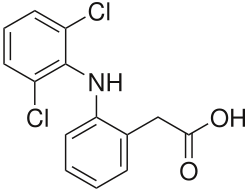
Diclofenac

Diclofenac, sold under the trade names Voltaren among others, is a nonsteroidal anti-inflammatory drug (NSAID) used to treat pain and inflammatory diseases such as gout. It is taken by mouth or applied to the skin. Improvements in pain typically occur within half an hour and last for as much as eight hours. It is also available in combination with misoprostol in an effort to decrease stomach problems.Voltaren (diclofenac) 50 mg enteric coated tabletsArthrotec (diclofenac and misoprostol) 50 mg tabletsDyloject (diclofenac) 2 ml for IV and IM administrationSintofarm (diclofenac) for suppository administration Diclofenac, sold under the trade names Voltaren among others, is a nonsteroidal anti-inflammatory drug (NSAID) used to treat pain and inflammatory diseases such as gout. It is taken by mouth or applied to the skin. Improvements in pain typically occur within half an hour and last for as much as eight hours. It is also available in combination with misoprostol in an effort to decrease stomach problems. Common side effects include abdominal pain, gastrointestinal bleeding, nausea, dizziness, headache, and swelling. Serious side effects may include heart disease, stroke, kidney problems, and stomach ulceration. Use is not recommended in the third trimester of pregnancy. It is likely safe during breastfeeding. It is believed to work by decreasing the production of prostaglandin. It blocks both cycloxygenase-1 (COX-1) and cycloxygenase-2 (COX-2). Diclofenac was patented in 1965 by Ciba-Geigy and came into medical use in the United States in 1988. It is available as a generic medication. In the United States the wholesale cost per dose is less than US$0.15 as of 2018. In 2016 it was the 78th most prescribed medication in the United States with more than 9 million prescriptions. It is available as both a sodium and a potassium salt. Diclofenac is used to treat pain, inflammatory disorders, and dysmenorrhea. Inflammatory disorders may include musculoskeletal complaints, especially arthritis, rheumatoid arthritis, polymyositis, dermatomyositis, osteoarthritis, dental pain, temporomandibular joint (TMJ) pain, spondylarthritis, ankylosing spondylitis, gout attacks, and pain management in cases of kidney stones and gallstones. An additional indication is the treatment of acute migraines. Diclofenac is used commonly to treat mild to moderate postoperative or post-traumatic pain, in particular when inflammation is also present, and is effective against menstrual pain and endometriosis. Diclofenac is also available in topical forms and has been found to be useful for osteoarthritis but not other types of long-term musculoskeletal pain. It may also help with actinic keratosis, and acute pain caused by minor strains, sprains, and contusions (bruises). In many countries, eye drops are sold to treat acute and chronic nonbacterial inflammation of the anterior part of the eyes (e.g., postoperative states). Diclofenac eye drops have also been used to manage pain for traumatic corneal abrasion. Diclofenac is often used to treat chronic pain associated with cancer, especially if inflammation is present. Diclofenac can be combined with opioids if needed such as a fixed combination of diclofenac and codeine.
